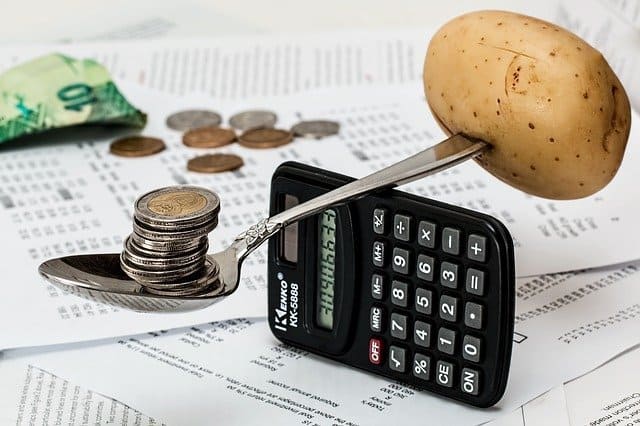Costs of investing: how can you reduce investment costs?
Investing costs money! In this article, I discuss what the main costs of investing are. With the tips in this article, you can also immediately lower your transaction fees!
What is the effect of costs on returns?
Many investors underestimate the effect of costs on the final return. A cost difference of 0.5% per year can save you a lot of money in the end. When you invest $1,000 per month with a return of 8%, you achieve the following results:
- At a cost percentage of 0%, your result is $1,490,359
- At a cost percentage of 0.5%, your result is $1,347,445
- At a cost percentage of 1%, your result is$1,219.000
Therefore, it is essential to pay attention to costs! In this article, I discuss how you can lower investment costs and achieve a higher return.
Monitor costs: compare first!
Before you start investing, it is wise to compare costs extensively. In one year, a higher cost percentage of one percent can easily cost you tens of thousands of dollars in returns. It is therefore important to carefully review the different transaction fees brokers charge.
Do you want to know where you can invest against low transaction fees? Use the button below to compare which broker charges you the lowest fees:
How can you lower your investment costs?
Tip 1: Avoid loss
The biggest cost item for investors is loss. Of course, it is impossible to completely avoid losses: investing is risky. However, by applying a good strategy and not investing in highly risky investment products, you reduce the chance of loss. You can do this by:
- Invest for the long term: this gives you time to recover when prices decline.
- Diversification: invest in different investment products.
- Dollar cost averaging: invest at different times.
Tip 2: Select a broker with low transaction fees
Transaction costs are the biggest cost item for many investors. Did you know that it is possible to invest without commissions at many brokers? In this article, I show you where you can do this.
Tip 3: Limit the number of transactions
Active investors often pay higher transaction costs. Some brokers, for example, charge a minimum fee for each transaction: it is then cheaper to buy $1,000 worth of shares at once than four times for $250.
Tip 4: Compare the stock listings
Some stocks and ETFs are listed on different exchanges. Research at which exchange it is most advantageous to trade in the security. Transaction fees can vary greatly between different exchanges. Some brokers also charge extra fees for trading on multiple exchanges: DEGIRO, for example, charges €2.50 per year for each exchange on which you trade.
Moreover, the stock listing may also be in a different currency. Some stocks can be traded in both euros and dollars. When you invest in a different currency than your own, you typically pay conversion costs. You can avoid these costs by investing in the currency you use.
Tip 5: Invest in cheap investment products
Not all investment products are equally cheap: you often pay higher transaction costs on crypto & stocks than on ETFs. Therefore, research what the costs are of the investment product in which you want to invest.
Tip 6: Research your personal situation
Whether a broker is cheap typically depends heavily on your personal situation. Therefore, first write down the following:
- How frequently do you want to invest?
- With what amount will you invest?
- What do you want to invest in?
For investors who invest small amounts, a broker with percentage costs may be more attractive. When investing a large amount, a fixed commission of $1 may be more attractive. By finding a product that suits your personal situation, you reduce your transaction costs.

How much does investing cost?
Transaction costs or commissions
At many brokers, you pay a commission on each investment. This commission typically consists of a percentage of the total value of the investment. Most brokers also charge a minimum number of fees.
Not all brokers directly charge transaction costs. For example, at brokers where you trade in CFDs, you do not pay direct commissions. In this article, you can read more about the costs of trading in CFD’s.
Spread on your investments
At all brokers, you also pay a spread. The spread is the difference between the purchase and sale price of, for example, a share. The spread is always relative. You pay a certain amount per share for the spread.
The fixed commission is often clearly indicated at a broker. Spreads are, however, more difficult to compare: the costs can vary per share. On one share, you may only pay two cents at a broker, while on another share, you may pay a dollar. Do you want to know where you can invest in a share against low fees? Then you will have to investigate what the spread for that share is at different brokers.
The spread typically rises during strong market movements & outside regular trading hours. Some brokers increase the spread themselves or sell orders on an expensive exchange.
It is regularly possible to receive a discount on your spread when investing large amounts. Contact your broker for this.
Currency costs or conversion costs
For foreign investments, you often pay costs for exchanging, for example, your dollars to euros. This naturally reduces the return on international investments. It is therefore important to examine how much it costs to invest in foreign stocks. Do you want to know how the exchange rate works? Then read this article.
Custodian fees or service fees
Especially traditional banks still charge so-called custodian fees. These are annual costs charged for holding securities. Fortunately, these costs can easily be avoided. Open a separate investment account where no custodian fees are charged. In our overview of brokers, you will find several brokers where you can invest without custodian fees.
Inactivity fees
At some brokers, you also have to pay money when you do not trade enough. You must then perform a minimum number of investments to avoid these costs. This cost item is especially annoying for the investor with a long-term vision.
Management fees
Investment funds generally charge management fees. These are costs for maintaining the portfolio. Other ongoing costs such as the administration and marketing costs of the fund are also charged in this percentage. Always remember that a more expensive fund is not always better! An index fund often has lower costs and achieves comparable or better returns than an actively managed investment fund.
Performance fees
Some funds also charge a performance fee. When a fund performs well, you have to give up part of the return. Incidentally, this only occurs with actively managed investment funds. No performance fees are charged for index funds and trackers.
Financing costs
When you invest on margin, for example with a derivative, you pay financing costs. With a derivative, you often invest with borrowed money, and you have to pay interest on it. Investing with borrowed money is rarely a good idea. Financing costs can quickly add up, especially when using a leverage.
Costs for services
Many brokers also charge fees for specific services, such as streaming live quotes or using a software package. It’s always wise to carefully read the fine print to prevent your investments from suddenly becoming much pricier.
Transferring securities in and out
Many brokers charge fees when you want to transfer your portfolio to another provider. Some brokers may offer to pay these fees for you. However, moving to another provider can be a hassle, so it’s best to avoid it as much as possible by choosing a good provider from the start.
Withdrawal fees
Some brokers also secretly charge fees for withdrawing funds, which can reduce your returns. Always check if a broker charges fees for withdrawing funds.
Reduce your costs by investing for free
Some brokers offer “free” investing, but be aware that brokers who offer this always have ulterior motives. This can be innocent. Some brokers offer free investing because they hope that customers will try other, more expensive investment products. Other brokers try to sneakily make money by charging fees for other services.
If you are eager to learn more about investing for free, refer to the article below to learn how it works:
Are expensive investment funds better?
People often have a psychological bias that expensive products are better. With investment products, this is typically not the case. For example, when you look at the returns of passive and active funds, you’ll see that passive funds frequently perform better. Active funds select stocks with the goal of beating the market, while passive funds track the market with an index.
The costs of an active fund are higher, but usually, the return is not higher. Even with the same return, you’ll achieve a much higher return with a passive fund. In 99% of cases, it’s best to choose the cheapest investment product.
The same rule applies when picking a broker. Cheaper brokers typically offer comparable options to more expensive ones. It’s almost always better to go with the most affordable provider, unless you’re looking for something very specific
Auteur

Over Alex Mostert
When I was 16, I secretly bought my first stock. Since that ‘proud moment’ I have been managing trading.info for over 10 years. It is my goal to educate people about financial freedom. After my studies business administration and psychology, I decided to put all my time in developing this website. Since I love to travel, I work from all over the world. Click here to read more about trading.info! Don’t hesitate to leave a comment under this article.
